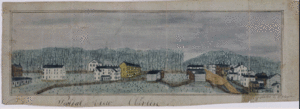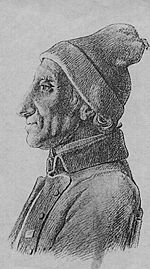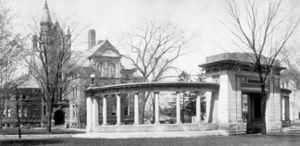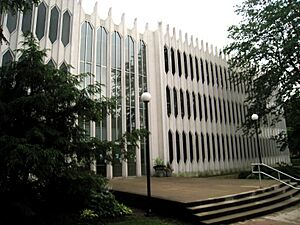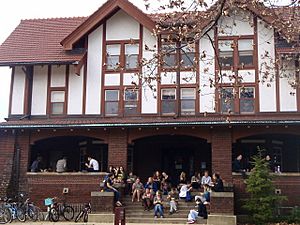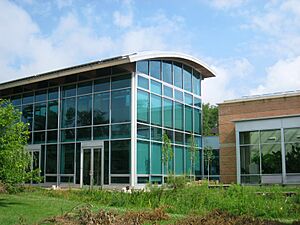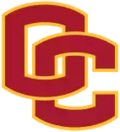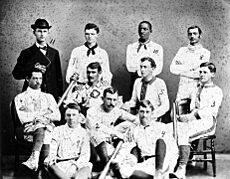Oberlin College facts for kids
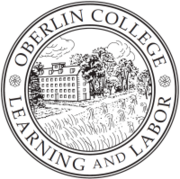 |
|
|
Former names
|
Oberlin Collegiate Institute (1833–1864) |
|---|---|
| Motto | Learning and Labor |
| Type | Private liberal arts college |
| Established | September 2, 1833 |
|
Academic affiliations
|
|
| Endowment | $1.09 billion (2021) |
| President | Carmen Twillie Ambar |
|
Academic staff
|
327 (2017) |
| Students | 2,785 (2019) |
| Location |
,
U.S.
41°17′35″N 82°13′18″W / 41.29306°N 82.22167°W |
| Campus | Suburban |
| Colors | Red & gold |
| Nickname | Yeomen / Yeowomen |
|
Sporting affiliations
|
NCAA Division III – NCAC |
| Mascot | Yeobie the Squirrel |
 |
|
Oberlin College is a private college and music school located in Oberlin, Ohio, United States. It was started in 1833. Oberlin is known for being the oldest college in the U.S. that allowed both men and women to study together. It was also one of the first colleges to accept African American students in 1835 and women in 1837.
Since its beginning, Oberlin has been famous for its students' efforts to bring about social change. The college offers over 60 different subjects to study. It is part of the Great Lakes Colleges Association and the Five Colleges of Ohio group.
Contents
History of Oberlin College
Oberlin College began as the Oberlin Institute in 1833. The people who founded the college wrote a lot about their ideas. Their writings were often featured in newspapers, especially the Liberator, which supported ending slavery. Many original letters and documents from that time still exist today.
How Oberlin College Started
The idea for Oberlin came from a dream to create a perfect Christian community in Ohio. The founders wanted to train missionaries and believed that slavery was a terrible wrong that needed to end right away. The college was inspired by a wave of Christian revivals in New York.
John Jay Shipherd and Philo Stewart, two Presbyterian ministers, founded the Oberlin Collegiate Institute in 1833. They built it on land given by Titus Street and Samuel Hughes.
They named the college after Jean-Frédéric Oberlin, a minister from France. He had brought positive social changes to a remote area, and Shipherd and Stewart hoped to do the same in Ohio.
Their goal was to create:
A community of Christian families with a Christian school. This school would be a place of strong religious influence. It would train workers for missionary work around the world. The school would use a system where students worked with their hands, and it would be open to both young men and young women. They planned to start with an academy for English and useful languages, and if possible, "practical Theology." This is why they chose the name "Oberlin College Institute."
The founders wanted a simple way of life. They encouraged people to avoid smoking, chewing tobacco, coffee, and tea. They also suggested simple clothes and homes. The main goal was to educate people to help others and spread their beliefs.
Students Join from Lane Seminary
When Oberlin College was first formed, the founders did not plan to include African American students. The issue of slavery was not part of the college's first plans. However, this changed when Oberlin agreed to accept students from Lane Seminary in Cincinnati.
These students, known as the "Lane Rebels," had left Lane Seminary. They demanded the right to freely discuss ending slavery and wanted the faculty to manage the school. They had held long debates about ending slavery versus sending freed slaves to Africa. They decided that slavery should end immediately.
The leaders at Lane Seminary were worried about protests and stopped these discussions. So, the Lane Rebels, including many students, left the seminary.
They met John Jay Shipherd, who invited them to Oberlin. The students agreed to come, but only if Oberlin met their conditions:
- Oberlin would accept African Americans equally. This was a very new and brave idea at the time. Other schools that tried this had faced violence. After much discussion, the trustees agreed to this on February 9, 1835.
- There would be no limits on discussing slavery or any other topic.
- Asa Mahan, a trustee who supported the students, would become president.
- Professor John Morgan, who was fired by Lane for supporting the students, would also be hired.
- The college's daily operations would be managed by the faculty. This idea of academic freedom was very important.
In the summer of 1835, President Mahan, Professor Finney, Professor Morgan, the Lane Rebels, and the first black students arrived at Oberlin. The Oberlin Anti-Slavery Society was formed in June 1835, calling for the immediate end of slavery.
Oberlin quickly became a major center for the movement to end slavery. It sent out many ministers and teachers who spoke out against slavery.
Oberlin in the 1800s
Asa Mahan became Oberlin's first president in 1835. He strongly believed in ending slavery right away, which shaped the college's ideas. In the same year, Oberlin started admitting African American students. In 1844, George Boyer Vashon became the first black student to graduate from Oberlin. He later helped start Howard University.
Oberlin was also the first college in the U.S. to admit women as full students in 1837. Four women were the first to enroll, and most of them graduated. Mary Jane Patterson was the first black woman to earn a bachelor's degree in 1862. Soon, women made up a large part of the student body.
In 1850, Charles Grandison Finney, a famous speaker and abolitionist, became the second president. Under his leadership, Oberlin's students and teachers became even more active in the anti-slavery movement. They helped runaway slaves on the Underground Railroad. Oberlin was known as a place that strongly opposed slavery.
In 1858, students and faculty were involved in the Oberlin–Wellington Rescue. They helped a runaway slave escape, which was reported in newspapers across the country. Some Oberlin residents also took part in John Brown's Raid on Harpers Ferry, a famous event against slavery.
After the Civil War, James Fairchild became Oberlin's third president in 1866. During his time, the college grew a lot. Oberlin also sent many Christian missionaries abroad. In 1881, a group of students called the Oberlin Band went to China as missionaries. Many of them died during the Boxer Rebellion in 1900. The Oberlin Shansi Memorial Association was created in their memory. It now helps Oberlin graduates teach in Asia and brings Asian scholars to Oberlin.
Oberlin in the 1900s
[[multiple image | align = right | direction = vertical | width = 220 | header = | header_align = left/right/center | footer_align = left/right/center | header_background = | footer_background = | image1 = Peters Hall Oberlin.JPG | width1 = 220 | alt1 = | caption1 = Peters Hall, home of the language departments, in 2010 | image2 = Oberlin College - Bosworth Hall.jpg | width2 = 220 | alt2 = | caption2 = Bosworth Hall | footer = ]] Henry Churchill King became president in 1902. Later, Robert K. Carr was president from 1960 to 1970, a time of much student activism. During his presidency, 15 new buildings were added. Students also became more involved in college decisions. In 1970, Oberlin was featured in Life magazine for having co-ed dorms, meaning boys and girls lived in the same buildings.
Robert W. Fuller became president in 1970. He worked to increase the number of minority students. He also hired the first four African American athletic coaches at a mostly white college. One of them was Tommie Smith, an Olympic gold medalist.
Later presidents included Emil Danenberg and S. Frederick Starr. Starr faced disagreements with students over issues like investing in companies connected to South Africa.
Oberlin in the 2000s
Nancy Dye became Oberlin's first female president in 1994. She oversaw new buildings and helped increase the college's funds. She was known for being easy to talk to. She served for almost 13 years. Marvin Krislov was president from 2007 to 2017. On May 30, 2017, Carmen Twillie Ambar became the 15th president. She is the first African American person and second woman to hold this role.
In 2013, the college had a "No Trespass List" that kept some people off campus. Students and town members protested this policy. The college later removed two students who were found to be responsible for hateful messages on campus, which they said was a "joke."
In 2016, a student was involved in an incident at Gibson's Bakery. This led to protests and a lawsuit against the college. In 2019, a jury decided the college was responsible for damages. In 2022, the court upheld this decision. In December 2022, Oberlin College paid the bakery over $36 million. The college hoped this would help the community heal.
Academics at Oberlin
| USNWR Liberal Arts College | 55 |
|---|---|
| Washington Monthly Liberal Arts | 114 |
| Forbes | 197 |
In 2025, U.S. News & World Report ranked Oberlin as tied for the 55th best liberal arts college in the U.S. Forbes ranked Oberlin 197th among all colleges and universities in America for 2024-25.
Most of Oberlin's nearly 3,000 students are in the College of Arts & Sciences. About 400 students are in the Conservatory of Music. Some students are in a special five-year program where they study in both the College and the Conservatory.
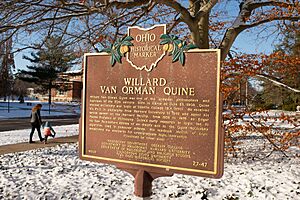
The College of Arts & Sciences offers over 50 main subjects, smaller subjects, and special areas of study. Some popular majors in 2023 were:
- Music Performance
- Psychology
- Biology
- Economics
- Politics
- Environmental Studies
- History
- Neuroscience
The Conservatory of Music is on the college campus. It is very hard to get into, with many students from around the world trying out for only about 120 spots. The Conservatory holds about 500 performances each year, and most are free. The Allen Memorial Art Museum at Oberlin has over 13,000 art pieces. It was the first college art museum west of the Allegheny Mountains.
College Libraries
The Oberlin College Libraries have special sections for art, music, and science. The main library is called the Mary Church Terrell Main Library. Students can find many books and media materials there. They also have access to over 46 million items from other Ohio schools through a group called OhioLINK.
Experimental College
Oberlin has an "Experimental College" or ExCo program. This program lets any student or interested person teach their own class for college credit. ExCo classes focus on topics not usually covered by other departments.
Winter Term
Oberlin's Winter Term happens every January. It is a time for students to explore interests outside of their regular classes. Students can work alone or in groups, on or off campus. They can create their own projects or choose from a list of projects and internships offered by the college. Students must complete a Winter Term project for three of their four years. Projects can include serious research, helping others, making films, or learning new skills.
Creativity and Leadership
The Creativity and Leadership department started in 2005. It helps students learn about and practice entrepreneurship. This department offers classes, workshops, and grants to students. One opportunity is the Creativity and Leadership Fellowship, which gives graduating seniors money to start their own business ideas.
In 2012, the department started LaunchU, a program for Oberlin students and alumni who want to start businesses. This program connects participants with business leaders and other entrepreneurs. It ends with a competition where participants can win up to $15,000 to fund their ideas.
Campus Life
Student Activism
Oberlin students have a long history of being active in social and political causes. The college is known for its liberal views. In the 1960s, the Memorial Arch was a gathering place for students supporting civil rights and protesting the Vietnam War. Oberlin students helped with many civil rights efforts.
In 2004, students protested against Coca-Cola products on campus due to concerns about the company's practices. The college stopped selling Coca-Cola products, but the ban was lifted in 2014.
In 2014, students protested for dining hall workers to be allowed to eat leftover food after their shifts. This led to workers being able to take food home. In 2015, students protested a tuition increase by temporarily taking over an administration building.
In December 2015, the Black Student Union at Oberlin made a list of demands. These included promoting black faculty and increasing the minimum wage for campus workers. The college responded by reviewing faculty positions and discussing wages.
Student Cooperative Association
The Oberlin Student Cooperative Association, or OSCA, is a student-run group. It provides housing for 174 students and food for 594 students. It is one of the largest student co-ops in North America.
OSCA is run entirely by students. All students who are part of OSCA work as cooks, buyers, or in other roles. They also do at least one hour of cleaning each week. Most decisions are made by group agreement. Oberlin does not have fraternities or sororities, so the co-ops are a big part of student social life.
Music and Arts
Besides the Oberlin Conservatory, there are many music groups for all students. Oberlin Steel is a steel pan band that has been performing for over 30 years. Oberlin College Taiko explores Japanese drumming. The Oberlin College Marching Band (OCMB) performs at sports events. There are also many a cappella singing groups. Students can also join chamber music groups and the Arts and Sciences Orchestra.

Film
The Apollo Theater in Oberlin opened in 1907. It was updated in 2012 and became the center for the Danny DeVito and Rhea Perlman Cinema Studies Center. This center has editing labs, an animation area, and a recording studio.
Sustainability Efforts
In 2006, Oberlin promised to become climate neutral by 2025. The college's Adam Joseph Lewis Center for Environmental Studies is a special building. It has a large solar panel system and a "Living Machine" that cleans water.
The school uses cleaner vehicles like biodiesel, hybrid, and electric vehicles. It also supports local public transportation. Each dorm shows how much electricity and water is being used. Students can also get grants for environmental projects on campus.
In 2012, Oberlin College received a "Gold" rating from the Sustainability Tracking, Assessment, and Rating System (STARS). This shows its strong commitment to being environmentally friendly.
Campus Publications and Media
Oberlin students create many different publications. The Oberlin Review is a weekly newspaper that covers current events. BIPOC Lenses is a newspaper for students of color.
There are also magazines like Wilder Voice for creative nonfiction, The Plum Creek Review for student writing and art, Headwaters Magazine for environmental topics, and The Synapse for science. WOBC News Corps, a part of the college radio station WOBC-FM, produces local news.
Athletics
Oberlin's sports teams are called the Yeomen (for men) and Yeowomen (for women). The name "Yeomen" came from combining "Oberlin Men" with the college's motto, "Learning and Labor." In 2014, the school chose the albino squirrel as its official mascot, named Yeobie.
Oberlin competes in the NCAA's Division III and the North Coast Athletic Conference (NCAC). Other schools in this conference include Kenyon College and Denison University. Kenyon is traditionally Oberlin's biggest rival.
Oberlin also has 17 club sports, such as ice hockey, fencing, ultimate frisbee, and rugby.
Baseball
On May 8, 2015, the Oberlin baseball team won the NCAC championship. This was their first baseball championship since joining the NCAC in 1984.
Football
Oberlin's football team was first coached by John Heisman in 1892. He led the team to a perfect 7–0 record. Oberlin is the last college in Ohio to beat Ohio State in football, winning 7–6 in 1921.
Cheerleading
Oberlin started a cheerleading squad again in 2011. The squad cheers for the football and basketball teams. They also help build school spirit.
Fencing
Oberlin has a club fencing team called the Flaming Blades. They practice and compete in different types of fencing.
Ultimate Frisbee
Oberlin has men's and women's Ultimate frisbee club teams, called the Flying Horsecows and the Preying Manti. The Preying Manti won the Division III national championship on May 19, 2019. The Flying Horsecows placed 5th nationally in 2022, their best finish ever.
Notable People
Many famous people have studied or taught at Oberlin. These include 16 Rhodes Scholars, 20 Truman Scholars, 15 MacArthur fellows, and 4 Nobel Prize winners. Oberlin has more MacArthur fellows than any other liberal arts college. It is also a top producer of Fulbright scholars.
See also
 In Spanish: Oberlin College para niños
In Spanish: Oberlin College para niños
- Mount Oberlin (Glacier National Park) – named after the college
- Oberlin College Press


